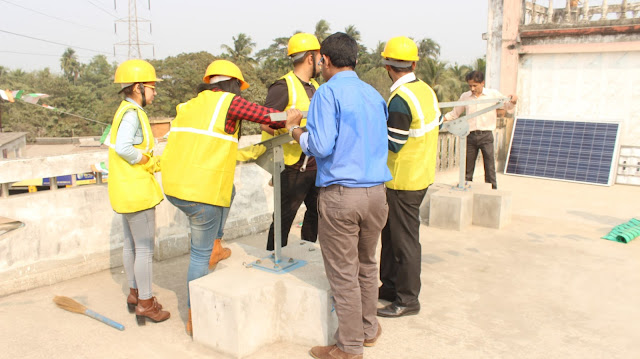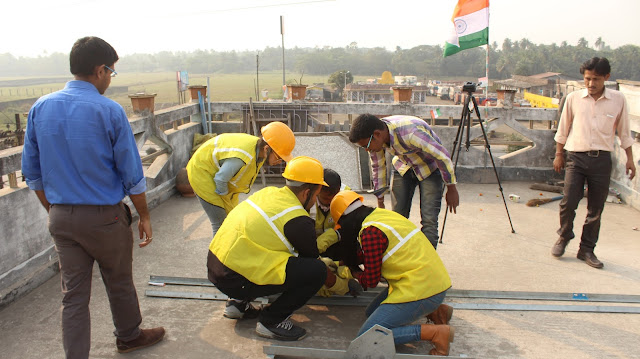Infrastructure
INFRASTRUCTURE OF SOLAR ENERGY TRAINING
Program Features
The training program has been especially designed to expand the skill set of technicians and increase their employ-ability in solar industry. They will be taught and updated about the latest practices of installation and operation of solar photovoltaic technology.
Technical Lab
The lab component has been especially designed for students to understand practical aspects of solar systems installation and operations. The Solar PV demo unit provides a platform for students to work on industrial equipment, by means of experiments and understand their installation, operations and maintenance aspects in addition to actual site visits accompanied by experts from the solar industry.
A cutting edge product to create skilled human resource for renewable energy sector in a Nation blessed with Institute of Solar Training. It will develop highly skilled workforce that enables the development of clean environment for human race also giving vast opportunity for exploitation of solar as energy source. The students would be able to grasp the conceptual nuances related to a PV plant functioning, which would equip them better to consult on design and operation issues related to it.
The system consists of individual plug-in units each with components for different experimental arrangements. The plug-in units can be connected according to the demand. The conception of the system allows indoor and outdoor experiments. Additional options are the change of slope angle of the module to see the effect of tilt. This system has measuring units for various parameters like Current, and Voltage of different networks of the circuits. Also has inbuilt Diodes, Batteries, Solar Charge controller and Inverter for completing a fully functional Stand along PV System. The overall objective of the PV Training Kit is to ensure that the students are able to better learn and grasp the concept related to the functioning of a PV Power plant so as be well equipped in Design, Installation, Operation and Maintenance of it. PV module I-V and P-V characteristics with series and parallel combination of modules, Effect of shading, Effect of tilt angle, Demonstration of diode working as Blocking and Bypass diode and stand alone system based experiments are the highlights of the experimental setup.
A 60 watt solar system used for training and research is available. It consists of poly crystalline solar panel with a capacity of 6 watts each. Module can be connected with stand alone setup. Collectively a maximum power of 60 watt can be produced. The whole usage of this system is, it can train the students in both standalone and grid connected system. The system demonstrates the performance of solar panels and also the functioning of two types of power conditioner unit – Grid tie system (without battery bank) and solar hybrid inverter (with Battery Bank). With this arrangement the Performance of different technologies with the different inverters can be studied by interchanging the solar panels with inverters. The influencing parameters like solar irradiation, Vmp, Imp can be measured and studied for influence of it on system performance and efficiency. The system display on meter monitor will give information of real time measurement of system parameters.
Solar Experimental Kit
It consists of
A cutting edge product to create skilled human resource for renewable energy sector in a Nation blessed with Institute of Solar Training. It will develop highly skilled workforce that enables the development of clean environment for human race also giving vast opportunity for exploitation of solar as energy source. The students would be able to grasp the conceptual nuances related to a PV plant functioning, which would equip them better to consult on design and operation issues related to it.
The system consists of individual plug-in units each with components for different experimental arrangements. The plug-in units can be connected according to the demand. The conception of the system allows indoor and outdoor experiments. Additional options are the change of slope angle of the module to see the effect of tilt. This system has measuring units for various parameters like Current, and Voltage of different networks of the circuits. Also has inbuilt Diodes, Batteries, Solar Charge controller and Inverter for completing a fully functional Stand along PV System. The overall objective of the PV Training Kit is to ensure that the students are able to better learn and grasp the concept related to the functioning of a PV Power plant so as be well equipped in Design, Installation, Operation and Maintenance of it. PV module I-V and P-V characteristics with series and parallel combination of modules, Effect of shading, Effect of tilt angle, Demonstration of diode working as Blocking and Bypass diode and stand alone system based experiments are the highlights of the experimental setup.
A 60 watt solar system used for training and research is available. It consists of poly crystalline solar panel with a capacity of 6 watts each. Module can be connected with stand alone setup. Collectively a maximum power of 60 watt can be produced. The whole usage of this system is, it can train the students in both standalone and grid connected system. The system demonstrates the performance of solar panels and also the functioning of two types of power conditioner unit – Grid tie system (without battery bank) and solar hybrid inverter (with Battery Bank). With this arrangement the Performance of different technologies with the different inverters can be studied by interchanging the solar panels with inverters. The influencing parameters like solar irradiation, Vmp, Imp can be measured and studied for influence of it on system performance and efficiency. The system display on meter monitor will give information of real time measurement of system parameters.
Solar Experimental Kit
It consists of
- PV Module characterization kit to study the effect of different angular positions, I-V Characteristics at different electrical connections
- PV System characterization kit to study the efficiency of the whole PV System by studying the efficiency of individual unit.
- Solar Simulator (solar cell characterization unit) to study the dependency of solar cell output on light intensity and temperature.
- Using the above units the students will get hands on experience in charge carrier life time measurement and the complete PV system working.
List of Experiments
A. PV characteristics:
1. Single PV module I-V and P-V characteristics. (with radiation and temperature changing effect)
2. I-V and P-V characteristics with series and parallel combination of modules.
3. Effect of shading.
4. Effect of tilt angle.
B. Stand alone system:
1. Battery charging and discharging characteristics.
2. Demo of only DC load system with and without battery. (with variable rated capacity of system)
3. Demo of only AC load system with and without battery.
4. Combine AC and DC load system with and without battery.
C. Solar Street Light System:
D. Solar Water Pump System
|
|
|
 |
| IST Student Hostel |






































